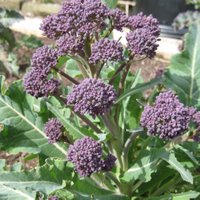Home › Home vegetable garden › Growing broccoli
Growing Broccoli
The Easiest of All Gourmet Vegetables

Growing broccoli is very easy and practically foolproof - even the most novice gardener is virtually guaranteed success.
What's more this delicious gourmet vegetable is very expensive to buy in the shops - two excellent reasons to follow this guide and find out how to grow broccoli for yourself!
Just to be clear, we are talking here about sprouting broccoli, those delicious, purple (OK sometimes white) spears with a flavour to rival asparagus, rather than calabrese, also known as American or Italian Broccoli.
Purple sprouting broccoli is a hardy biennial meaning that it is planted one year and flowers the next. It is a member of the Brassica family which also includes cabbages, cauliflowers, kale and brussels sprouts.
Sprouting broccoli is also one of the hardiest vegetables surviving down to around -12 degrees C (10 degrees F) making it a really useful crop in colder areas. In the US it will grow in USDA Hardiness Zones 3-10.
One of the best things about growing broccoli is that it is ready to harvest from late winter into spring, a time when there isn't an abundance of fresh produce in your vegetable garden.
Have I persuaded you to give it a go? I do hope so!
Soil Requirements
Sprouting broccoli isn't too fussy about soil although, like all members of the brassica family, it prefers an alkaline, fertile, moisture retentive but well drained soil.
As the plants will be in the ground for the better part of a year, the fertility is important. However don't plant it in freshly manured ground as the nitrogen levels are too high and you will end up with a lot of lush sappy growth that is prone to pests and diseases.
I like growing broccoli on a patch of ground that has had manure applied in the previous season for a different crop. If this isn't possible apply some blood, fish and bone when you transplant the seedlings to their final positions and they will do just fine.
These are big leafy plants, 60-90cm (2-3ft) high, and rather top heavy, so to give them a firm foundation by not digging over the soil before you plant.
I have also had good results growing broccoli in my raised bed vegetable garden (if you try this, follow the advice below about planting depth), and truly excellent results (rather surprisingly) when I planted some spare seedlings in a new no dig garden bed.
When and How to Sow
Sow the seed in late April to early May, either in a seed bed or in modules.
Sow the seeds thinly at a depth of 1cm (0.5in) and, once the seedlings emerge and are big enough to handle, thin them out to 7.5-10cm (3-4in) apart and let them grow on.
By June or early July the growing broccoli plants should be ready to transplant to their final positions. If space is at a premium you can position the broccoli plants 45cm (18in) apart but if at all possible allow 60cm (2ft) between plants. Water in after transplanting.
Tip: To give more stability to your sprouting broccoli, plant at a depth of about 10cm (4in) with the lower leaves just above soil level and firm the soil around them. You can also earth up your growing broccoli plants by mounding soil around the stems as they grow.
Routine Maintenance
Water during any dry periods to avoid a check in growth.
Keep weeds down by hoeing, or better still, by applying either an organic mulch or black plastic around the plants to suppress any weed growth.
To boost growth you can apply a general purpose fertilizer in early August.
In exposed or windy areas stake each plant to prevent them from flopping over.
When and How to Harvest
Sprouting broccoli is a' cut and come again' crop. Depending on the variety you are growing you will notice the spears start to develop in late winter or early spring.
Either snap them off with your fingers or use a sharp knife to cut them when they are 10-15cm (4-6in) long and the flowers are in bud.
Tip: To prolong the harvesting period pick the shoots regularly, say twice a week, so that none are left to run to seed. The more spears you pick, the more will be produced. Once the broccoli produces its yellow flowers it will also stop producing new young shoots.
Pests and Diseases
Cabbage white butterfly
You may be aware that the Brassica family is prone to a number of pests, including the dreaded cabbage white butterfly, but please be assured that sprouting broccoli is remarkably pest free, largely because the edible shoots, the part that you eat, form in late winter to spring when there are no cabbage white butterflies about.
Even if the cabbage white attacks your broccoli during the preceeding summer, it does not usually cause a problem, but if you are worried you can simply pick off the caterpillars by hand.
Pigeons
Hungry pigeons can be a problem in some areas. They seem to relish broccoli leaves and peck them to shreds, leaving your plants incapable of producing any sprouts.
The remedy is straightforward: drape them (the broccoli plants, not the pigeons) with a very fine mesh netting so that the birds cannot push their beaks through.
Clubroot
The other main potential problem is clubroot. This disease is caused by a fungus that can live in the soil for many years. It thrives in acid soils and causes the roots of brassicas to swell and become distorted before eventually rotting. Any affected plants will be stunted and useless.
Growing broccoli from seed, rather than buying in young plants which may be infected, is the number one preventative measure. Sprouting broccoli should also be a part of your crop rotation plan (there is a simple three year rotation plan in our raised bed vegetable gardening section).
If you know or suspect that your soil is infected with clubroot all is not lost. Carry out a soil pH test two months before planting time and add lime to raise the pH to around 7.5.
Sow the broccoli seeds in modules filled with sterile potting compost. Instead of planting them out, transfer them to larger pots and grow on until they are well established.
At this point you can plant them out in their final cropping positions. Nine times out of ten broccoli plants raised this way will be healthy and vigorous enough to fend off the clubroot.
As a final precaution make sure that you don't add any parts of infected plants to your compost heap.
For More Information...
More information on vegetable growing can be found at creating a successful home vegetable garden.
If you're new to vegetable gardening, do try these other easy vegetables to grow.
Globe artichokes are another easy vegetable in the gourmet league. Don't spend a fortune at the grocery store, instead grow your own. Growing artichokes shows you how.
And why not try your hand at growing your own potatoes? They are easier to grow than you might think. How to grow potatoes gives you all the information you need.
Home › Home vegetable garden › Growing broccoli
